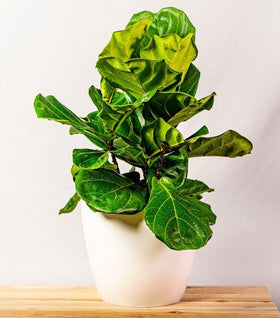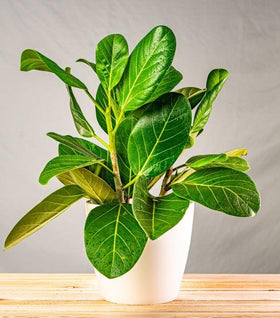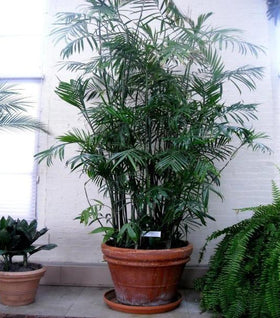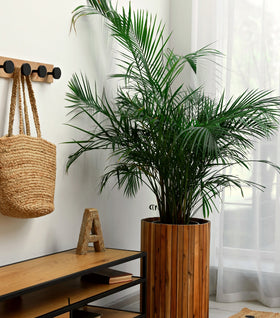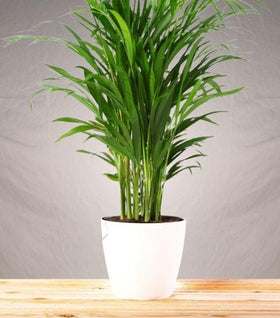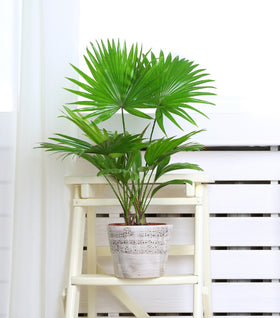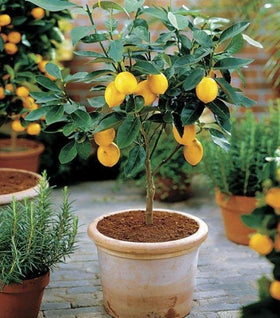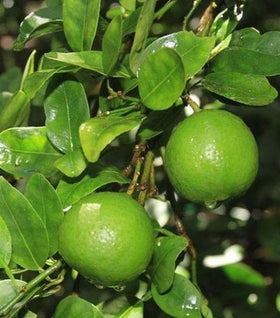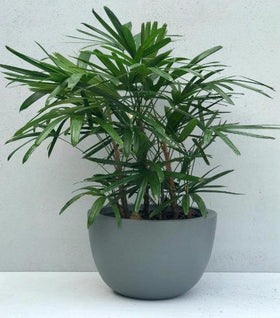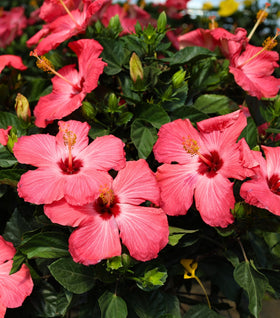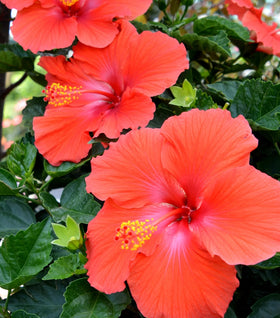Indoor Trees For Sale Online
Indoor trees have the same effect in a room that a large piece of furniture has. Similar to a large painting in your living room, a houseplant tree can bring a room together and give scale to an otherwise open area. Some popular indoor trees include Palm Trees, Rubber Trees, Parlor Palms, Fiddle Leaf Figs, and so many more.
You can even grow citrus trees indoors, and they will produce fruit that you can enjoy! Most indoor trees require full sun light conditions and are fairly easy to grow. Care-taking tips for houseplant trees when it comes to light and water is to not allow your plant's roots to sit in standing water or else they will get root rot.
Tips for selecting an Indoor Tree
There are a wide variety of indoor trees and plants available today. When you've made the decision to purchase an Indoor tree or any live plant there are a few questions you may have.
How much light will my indoor tree need?
Most of the indoor trees sold today prefer bright indirect light. Locate indoor trees near a southern window when possible but an eastern or western exposure will work as well. The ideal light situation is ambient light rather than direct sunlight.
How much water does an indoor tree need?
Watering potted plants is not as complicated as it may seem. There is no set schedule but deciding if the tree needs water is as simple as sticking your finger in the soil. If the soil feels wet then there's no need to water.
The soil in a pot dries from the top down so if the top is dry, It's ok to water. Typically indoor trees will need water once per week during the growing season.
How tall will an indoor tree get?
This will vary from tree to tree. Palms, for instance, will get to 6 feet or so ficus trees including Fiddle Leaf Figs can get to 10 to 12 feet tall. We always tell people that an indoor tree is like a fish in a tank. The fish will naturally not outgrow its space, neither will an indoor tree.
Simply pruning the growing tips of a taller tree will stop it from growing taller and will force it to branch and become denser.
Are there any indoor trees that are clean air plants?
Yes, Palms are some of the best clean air plants available, Palms are easy to grow and function very well as clean air plants. Ficus are also very effective air cleaners.
Are there any Pet-friendly Indoor Trees?
Palms are very pet-safe plants. There are other plants that are clean-air plants. Dracaena is also a great plant for this purpose. Areca Palms have been found to produce more oxygen than snake plants which were once thought to be the best indoor clean air plants.
Types of Indoor Trees:
Fiddle Leaf Figs
Arguably the most popular houseplants available, Fiddle Leaf Fig trees are loved by plant parents of all experience levels. These indoor plants are known for their large, distinct, violin-shaped leaves and come in both tall trees and bushes. This tough plant adapts easily to conditions, and once acclimated, it can grow up to 6 feet tall. We suggest placing your tree in bright, indirect light and well-draining potting soil.
These tropical plants are susceptible to root rot, so you must allow their soil to dry before watering. When the top 2 inches of soil are dry, it is time to water your plant. However, avoid hitting their leaves with water because this could cause brown spots and other serious damage. Whether you live in a spacious home or cozy apartment, buying a Fiddle Leaf Fig plant will be the perfect addition to your interior design.
- Fiddle Leaf Fig Tree
- Little Fiddle Leaf Fig Tree
- Fiddle Leaf Fig Bush
Ficus
Indoor Ficus Trees are among the most popular indoor plants grown today. These house plant trees are also known as fig ficus trees. Ficus trees are easy to grow indoors as long as you give them bright, indirect light and well-draining potting mix. Don't forget to pot your houseplant in a container with excellent drainage holes.
Your rubber tree will grow and thrive during the spring and summer and will go dormant during the fall and winter. These ficus plants can vary from long-leaved trees to large-leaved Fiddle Leaf Figs. If you notice your rubber plant's leaves turn yellow or you notice some leaf drop, this could mean your plant is overwatered.
- Braided Ficus Benjamina Weeping Fig Tree
- Ficus Benjamina Tree
- Braided Stem Ficus Alii Tree
- Ficus Alii Tree
- Ficus Audrey Tree
Hibiscus
Tropical Hibiscus plants are known to produce dramatic, vibrant flowers in an indoor environment year-round. Hibiscus flowers are trumpet-shaped blooms that can be as large as 8 inches wide. They do last a short period but don't worry; they produce flowers constantly! Lucky for you, your pets, and your loved ones, this houseplant is non-toxic and will not cause any harm or damage.
Grow your indoor hibiscus near a south-facing window where they can receive full sun and some partial shade. If you have a south-facing sunny window that gets some shade throughout the day, your flowering plant will thrive best here! Give them moist but well-draining potting soil with semi-acidic ph levels.
- Tropical Hibiscus Tree
- Red Tropical Hibiscus Tree
- Pink Tropical Hibiscus Tree
Palms
Palm trees are slow-growers that instantly adapt to any condition and require little to no maintenance. Indoor palm plants are great for beginners and children of all ages- a great introductory plant to the world of houseplants. Palms, like Bamboo Palm or Majesty Palm, are efficient air-cleaning plants. These tropical plants add beauty and function to your home, apartment, office, or any indoor space!
The one thing to watch out for with these houseplants is that they are susceptible to root rot and spider mites. You can avoid root rot by potting them in well-draining soil and a pot with excellent drainage holes. Palms prefer this kind of soil condition, and if you notice their leaves turn brown, your plant may be experiencing root rot. Majesty Palm.
- Majesty Palm
- Cat Palm
- Lady Palm
- Bamboo Palm
- Areca Palm
Citrus Trees
Meyer Lemon Trees produce fruit along with fragrant white blooms. The Improved Meyer Lemon Tree is a must-have houseplant that is rare for its flowering and fruiting abilities. These indoor citrus trees prefer a well-draining potting mix and to be in bright, indirect sunlight. It is time to pick your lemons when they are yellow and soft to the touch.
Key Lime Trees grow in very similar indoor environments as the Meyer Lemon tree. This fruit tree features evergreen, oval foliage, white flowers and produces golf-ball-sized limes. What's better than making homemade key lime pie with limes you grew in your own home?
Money Tree
Money Trees bring a tropical feel to any indoor space. This plant can reach heights of 6 feet when planted indoors. Money Tree plants grow best in medium to bright, indirect light, and well-draining potting mix. These houseplants also thrive in humid climates, and there are a few ways you can increase the humidity in your home.
Always make sure the container your plant is in has excellent drainage holes, so when you water the plant, its roots won't sit in standing water. You can also add a pebble tray under the pot to increase humidity. Money Tree plants are loved by bonsai enthusiasts because they bring good luck, positive energy, and are low maintenance.
Dracaena marginata
The dark green leaves of Dragon Trees are slender and arc slightly, creating a very graceful, slender form. Dracaenas do well in fluorescent to bright, indirect light. They do well in offices or living rooms away from windows or natural light. They help to clean the air of indoor toxins, such as benzene, formaldehyde, and trichloroethylene.
Sea Grape Plants
Sea Grapes or Coccoloba gets its name from the grape-like fruits that are born in clusters. Sea Grape Plants produce edible fruits that can be eaten raw but are best in jams and jellies. If you've spent any time in Florida, you have surely seen this plant. In the north, coccoloba uvifera can be grown indoors but will not produce large clusters of fruit.


